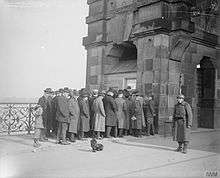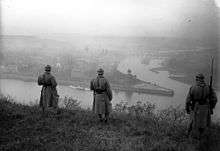Occupation of the Rhineland
The Occupation of the Rhineland from 1 December 1918 until 30 June 1930 was a consequence of the collapse of the Imperial German Army in 1918. Despite Germany's proving victorious on the eastern front following the Russian Revolution, the military high command had failed to prevent the continuing erosion of morale, both domestically and in the army. Despite transferring veteran troops from the eastern front to fight on the western front, the Spring Offensive was a failure and following the outbreak of the German Revolution, Germany's provisional government was obliged to agree to the terms of the 1918 armistice. This included accepting that the troops of the victorious powers occupied the left bank of the Rhine and four right bank "bridgeheads" with a 30 kilometres (19 mi) radius around Cologne, Koblenz, Mainz and a 10 kilometres (6 mi) radius around Kehl. Furthermore, the left bank of the Rhine and a 50 kilometres (31 mi)-wide strip east of the Rhine was declared a demilitarized zone. The Treaty of Versailles repeated these provisions, but limited the presence of the foreign troops to fifteen years after the signing of the treaty (until 1934). The purpose of the occupation was on the one hand to give France security against a renewed German attack, and on the other to serve as a guarantee for reparations obligations. After this was apparently achieved with the Young Plan, the occupation of the Rhineland was prematurely ended on 30 June 1930. The administration of occupied Rhineland was under the jurisdiction of the Inter-Allied Rhineland High Commission with its seat at the Upper Presidium of the Rhine Province in Koblenz.

— blue: France , including the former American zone around Koblenz
— yellow: Belgium
— brown: United Kingdom
— stripes : Ruhr, occupied by France and Belgium
— green: Saar, occupied by France under the auspices of the League of Nations[1] French forces continued to occupy German territory in the Rhineland until the end of 1930, while France continued to control the smaller Saarland region until 1935.[2]
.jpeg) The Watch on the Rhine, (The Last Phase) by Sir William Rothenstein | |
| Date | 1 December 1918 – 30 June 1930 |
|---|---|
| Duration | 11 years, 6 months, 4 weeks and 1 day |
| Location | Rhineland, Prussia, German Empire |
| Coordinates | 50°21′26.7″N 7°36′07.0″E |
Periods
- Armistice of Compiégne (11 November 1918 – 13 December 1918)
- First prolongation of the armistice (13 December 1918 – 16 January 1919)
- Second prolongation of the armistice (16 January 1919 – 16 February 1919)
- Third prolongation of the armistice (16 February 1919 – 10 January 1920)
- 28 June 1919: Signing of the Treaty of Versailles and the Rhineland Agreement
- 10 January 1920: Treaty of Versailles and Rhineland Agreement come into force; Foundation of the Inter-Allied Rhineland High Commission
- 1926: Withdrawal from the Northern Zone around Cologne
- 1929: Withdrawal from the Central Zone around Koblenz
- 1930: Withdrawal from the Southern Zone around Mainz, resulting in the end of the occupation
- 1936: Remilitarization of the Rhineland by German troops under Hitler, on March 7.
Occupying forces


American Forces (1918–1923)
The United States occupied the central area of the Rhineland along the Mosel river and the Koblenz bridgehead. General John J. Pershing, commander of the American Expeditionary Forces (A. E. F.), created the Third US Army for this purpose, giving the command to Major General Joseph T. Dickman. In early 1919, the Third Army comprised some 250,000 men.[3] The Americans opened their headquarters in a Prussian government building by the Rhine in Koblenz. In these days, the Stars & Stripes flew over Ehrenbreitstein Fortress.[4] In July 1919, the Third Army was disbanded and replaced by the American Forces in Germany (AFG) under the command of Major General Henry Tureman Allen. After a constant troop withdrawal, the AFG comprised some 20,000 men in a reduced territory in late 1919.[5] Compared to the French occupation zone, the Americans got along with the German population much better, including a number of love affairs. General Allen took even part in saving Ehrenbreitstein Fortress from destruction by the Allied forces in 1922.[6] After more than four years of occupation, the Harding administration decided to bring the troops back home. Finally, the last Americans left their headquarters in Koblenz in January 1923. The American occupation zone was consequently handed over to the French, who from that moment on controlled the major portion of the occupied Rhineland.[7]
Belgian forces

This consisted of 20,000 soldiers (five divisions)[8] with its headquarters at Aachen,[9] and with its troops stationed in Krefeld.[10] They were commanded by Armand Huyghé.
British Army of the Rhine
The British Army entered German territory on 3 December 1918.[11] The British Army of the Rhine was established as the occupying force in March 1919. Based at Cologne, they published The Cologne Post.
French Army of the Rhine

The French Eighth and Tenth armies originally constituted the French forces involved in the occupation. The Eighth Army was commanded by General Augustin Gérard and occupied the Palatinate. The Tenth Army was commanded by General Charles Mangin and was responsible for the rest of the French zone from its headquarters in Mainz.
On 21 October 1919, they were combined to form the French Army of the Rhine.
In 1919 France stationed between 25,000 and 40,000 French colonial soldiers in the Rhineland.[12] Some German women married African soldiers from the occupying forces, while others had children by them out of wedlock (hence the disparaging label "Rhineland Bastards")[13] and were considered by right-wing Germans to constitute a public disgrace.[14] General Henry Tureman Allen reported to the US Secretary of State that from the start of the occupation until June 1920 there were 66 cases of formal accusations against colored colonial troops, out of which there were 28 convictions, and admits there were many more unreported cases.[15] Despite these occasional cases, "the wholesale atrocities by French negro Colonial troops alleged in the German press, such as the alleged abductions, followed by rape, mutilation, murder and concealment of the bodies of the victims are false and intended as political propaganda".[16]

French occupation of Frankfurt occurred from 6 April to 17 May 1920. On the second day nine civilians were shot by Moroccan troops in an incident outside the Hauptwache. This incident was used to launch a racist campaign against the French use of colonial troops, linking the incident with allegations of wide spread assaults by Black soldiers in the French occupation army on local women[15] including accusations of systemic rape and other atrocities targeting the German civilian population and attributed mainly to Senegalese Tirailleurs.[17] The events resulted in a widespread campaign by the German right-wing press, which dubbed them as "The Black Shame" (Die schwarze Schande or Die schwarze Schmach) and depicted them as a form of French humiliation of the German nation.[18]
In 1923, in response to German failure to pay reparations under the Treaty of Versailles, France and Belgium occupied the industrial Ruhr area of Germany, most of which lies across the river on the east bank of the Rhine, until 1925. Many Germans were killed during civil disobedience protests. e.g. against dismissal of German officials.[19][20]
Siamese Expeditionary Forces
The Siamese Expeditionary Forces also participated in the occupation until 1919 with their troops being stationed in Neustadt an der Weinstraße, located in the French area.
References
- Edmonds, (1943), p. 1
- Emmanuel Pénicaut. "L'armée française en Sarre, 1918-1930" (in French)., Revue historique des armées, Service historique de la défense.
- Holzheimer (2019), pp. 12-15
- Holzheimer (2019), pp. 62-65
- Holzheimer (2019), pp. 51-54
- Holzheimer (2019), pp. 75-76
- Holzheimer (2019), pp. 181-184
- Pawley (2008) p. 39
- Anne, Godfroid. "Occupation after the War (Belgium and France)". 1914-1918-online. International Encyclopedia of the First World War. Retrieved 30 July 2019.
- Pawley (2008) p. 41
- Philip Gibbs on the Allied Occupation of the Rhineland, December 1918 accessed 11 September 2010
- Wigger (2010) p. 35
- Tina Campt, Other Germans: Black Germans and the Politics of Race, Gender, and Memory in the Third Reich (University of Michigan Press, 2004), p. 50 ff.
- Julia Roos, "Women's Rights, Nationalist Anxiety, and the 'Moral' Agenda in the Early Weimar Republic: Revisiting the 'Black Horror' Campaign against France's African Occupation Troops". Central European History, 42 (September 2009), 473–508.
- "Finds Negro troops orderly on Rhine" (PDF). The New York Times. 20 February 1921.
Undoubtedly many cases have occurred where many girls or women have been assaulted by of the French colored Colonial troops...cases which were not included in official figures...natural desire to keep out...
- "FINDS NEGRO TROOPS ORDERLY ON RHINE; General Allen Reports Charges Are German Propaganda, 'Especially for America'", The New York Times, 20 February 1921
- LES TIRAILLEURS SENEGALAIS ET L’ANTHROPOLOGIE COLONIALE UN LITIGE FRANCO-ALLEMAND AUX LENDEMAINS DE LA PREMIERE GUERRE MONDIALE, Hans-Jürgen Lüsebrink
- La « Honte Noire ». Racisme et propagande allemande après la Première Guerre mondiale, Estelle Fohr-Prigent
- "Anaconda Standard". 10 February 1923.
Twenty Germans were said to have been killed and several French soldiers wounded when a mob at Rapoch attempted to prevent the expulsion of one hundred officials. Picture shows French guard being doubled outside the station at Bochum following a collision between German mob and the French
- "Hanover Evening Sun". 15 March 1923.
Three Germans killed in Ruhr by French sentries
Bibliography
- Edmonds, J.E. (1987) [1943]. The Occupation of the Rhineland 1918–29. HMSO. ISBN 978-0-11-290454-0.
- Holzheimer, Marc (2019). The American Occupation of the Rhineland, 1918-1923. ISBN 9781092160933.
- Pawley, Margaret (2008). The Watch on the Rhine: The Military Occupation of the Rhineland, 1918–1930. I.B.Tauris. ISBN 978-1-84511-457-2.
- Wigger, Iris (2010). "'Black Shame' – the campaign against 'racial degeneration' and female degradation in interwar Europe". Race and Class. Institute of Race Relations. 51 (3). ISBN 978-1-84787-414-6. ISSN 0306-3968.
External links
| Wikimedia Commons has media related to Occupation of the Rhineland. |
- The French Occupation of the Rhineland, 1918–1930
- Map of Europe during the Occupation of the Rhineland at omniatlas.com